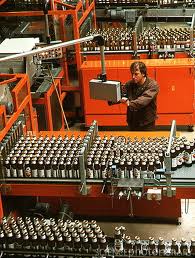 When you mention a new high-tech solution to someone in manufacturing, you might see their eyes roll. If you’ve been in the industry long enough, you’ve seen new, trendy technologies over promise, under deliver and disappear as fast as they came. But, for all of the failures we clearly remember, there are far more successes that aren’t as memorable. Automation has increased, networks have become more connected and the data gathered from the manufacturing process has shot through the roof. We’ve come a long way in a short period of time and the future of manufacturing is becoming more clear. Here’s what we see:
When you mention a new high-tech solution to someone in manufacturing, you might see their eyes roll. If you’ve been in the industry long enough, you’ve seen new, trendy technologies over promise, under deliver and disappear as fast as they came. But, for all of the failures we clearly remember, there are far more successes that aren’t as memorable. Automation has increased, networks have become more connected and the data gathered from the manufacturing process has shot through the roof. We’ve come a long way in a short period of time and the future of manufacturing is becoming more clear. Here’s what we see:
Increased quality data and traceability
You can’t improve what you can’t measure so we are attempting to measure everything throughout the manufacturing process and making that data available in real time. This gives manufacturers the ability to avoid expensive mistakes, make better decisions and meet their consumers’ demand. Digital sensors and smart tags provide the visibility manufacturer’s need to control product flow and increase production flexibility.
Real-time enterprise planning and supply chain management
We’ve seen this trend underway for at least a decade, a few manufacturers paid the price for adopting too early, but deep integration between enterprise planning and supply-chain management software has become standardized and commonplace. The new trend is how these systems communicate. With the influx of new data points, algorithms are more advanced and more useful. For instance, the supply chain can drive a production schedule using automated controls based on consumer demand measured within an ERP.
To implement these solutions, manufacturers will need to make industrial network upgrades that allow for greater bandwidth, reliability and security. An added bonus is that the new hardware and software is more intuitive so that extensive training won’t be a prerequisite for operation.
Flexible manufacturing for small batch production and mass customization
Customers want customized, small batch products more than ever. Once manufacturers have integrated their ERP and SCM systems, their line needs the flexibility to accommodate real-time decisions. These line changes don’t need to result in accumulating costs and downtime. The automotive market has invested in interchangeable tooling to enable agile manufacturing between models and variations with no loss in efficiency and cost.
Predictive analytics for equipment management
All of these trends build on one another, and at the most advanced part of the long-term trends, we see a renewed focus on equipment management. Manufacturers are slowly giving up the idea that a machine should run as long as possible, even after obsolescence. The real costs of old machines and software is becoming apparent. Spare parts for programmable controllers and drives are becoming harder to find and technology provider support is sunsetting. Overall efficiency and productivity is threatened by the risks of downtime from last resort rip-and-replace tactics.
When manufacturers make the transition to modern machines and hardware, they realize new benefits. Sustainable manufacturing means that energy monitoring, machine safety and predictive maintenance will be built into hardware and process from the start instead of being piecemealed together.
Integrated machine safety
Machine and Plant Safety is a high priority for manufacturers for the next few years. 75% of U.S. plants are over 20 years old and there is a staggering number of manufacturing assets that are not within safety compliance. Safety has been tacked onto lines for year, but new machines and hardware have safety measures integrated from the start. When safety is built-in there are reduced near misses, incidents and unplanned downtimes.
The costs have come down enough that manufacturers of all sizes are moving towards at least one of these long term manufacturing trends. These aren’t just trends, they are movements to a faster, more flexible and safe future. We look forward to helping manufacturers plan and implement new technologies so that they can ensure long term success.



